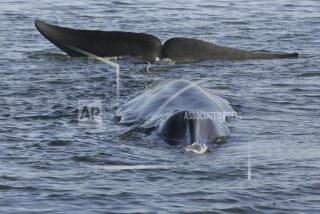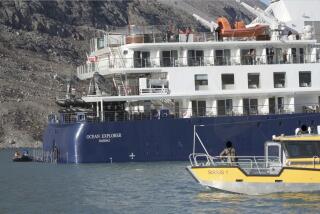High-Tech Fishing Perils Island Life Style
STROMNESS, Orkney Islands — The bridge of the huge trawler Orcades Viking hums with banks of computers and sonar that can pick up schools of fish up to two miles away.
The crew can then set their nets at the correct depth and scoop up anything in their path. Dolphins and even whales have turned up in the catch, said Joseph Nicholson, co-owner of the 1,100-ton trawler.
The technology is such that the Viking could catch its whole year’s quota of mackerel and herring in a week.
“The potential’s unlimited, really. The best haul we had last year was 1,500 tons in one hour’s fishing,” said Nicholson’s partner, Angus Sinclair.
Luckily for the North Sea fish, quotas in Britain are strictly enforced.
“Quotas are there so we don’t overfish the seas and ruin the future of the entire fishing industry,” said a spokeswoman for the Ministry of Agriculture.
Sinclair and Nicholson sold $1.9-million worth of fish last year and made a profit of $640,000.
But many Scottish fishermen think they get a raw deal from the European Community and its fishing quotas.
There are enough fish in British waters for the British fishing fleet, said one fisherman who declined to be named, “but now that we’re in the EC it’s all got to be shared out. The EC’s a bad thing for us.”
By a quirk in the rules, Norwegian trawlers are allowed to fish for mackerel and herring in the British half of the North Sea but British ships are barred from doing the same in the Norwegian sector, fishermen said.
Norwegian ships also seem to be subjected to less rigorous controls, they claim.
Scottish fleets are allowed to fish mackerel only in season.
“They (the Norwegians) seem to be fishing all year, they start the season earlier and go on longer,” said the fisherman.
The Viking is allowed to take only 4,400 tons of mackerel and 1,500 tons of herring a year.
And since EC quotas for 1990, decided in Brussels in December, reduce the British quotas for both herring and mackerel, the Viking and other North Sea fishing fleets are likely to be allowed to catch even less this year.
Once the Viking has caught its mackerel and herring quota, the ship spends several months fishing for less profitable blue whiting, which is not protected by quotas.
And for four months during the winter the ship sits idle in its home port of Stromness in the Orkney Islands off the northeastern tip of Scotland.
Although relatively small compared to some of the Norwegian fleet, the Viking can hold 1,500 tons of fish at a time. The catch is transferred from nets to tanks through a powerful suction tube.
Moored in Stromness harbor, the Viking dwarfs the brightly painted wooden fishing boats bobbing beside it and the modest stone cottages around the port.
Sinclair and Nicholson are both natives of these bleak, wind-swept islands. Nicholson started in business by buying a rowboat, went on to buy a second and then moved up to a fishing boat. When that got too small, he got a Norwegian shipyard to cut it in half and add a new middle section.
Two years ago he and Sinclair bought the Viking for $4.3 million.
The 12-member crew of local men earn wages that are generous for the islands, where a three-bedroom house can be had for a quarter of the price of an apartment in London.
Now in their mid-30s, Sinclair and Nicholson are among the most affluent men in a community that makes its living largely from sheep farming, fishing, whiskey distilling and a small number of tourists.
More to Read
Sign up for Essential California
The most important California stories and recommendations in your inbox every morning.
You may occasionally receive promotional content from the Los Angeles Times.










